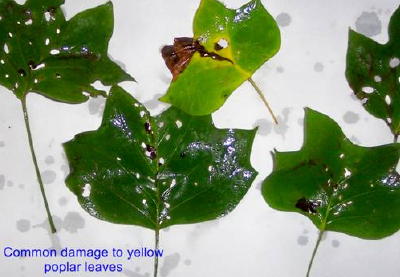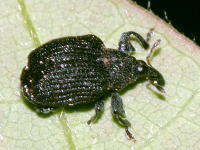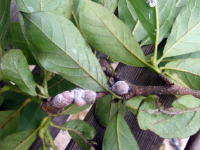
Common damage to yellow poplar leaves
By Russ Richardson, Forester
Area residents can still remember the recent winter that never happened. It now appears that yellow poplar trees in local woodlands are showing the effect of never having enough frigid weather during the winter to kill off damaging insect pests.
During the past couple weeks anyone driving local hardtop roads may have noticed dark spots in the pavement where the road surface almost looked greasy or people may have been out in the woods and noticed that a lot of extra sunlight seems to be reaching the forest floor in areas where yellow poplar trees are a very common part of the forest.
In woodland where yellow poplar defoliation is heaviest the ground cover and lower vegetation is shiny and covered with a sticky and greasy film, which is actually the liquefied poop of the bugs eating the leaves.
Government experts have yet to figure out the exact pests responsible for causing damage to yellow poplar foliage but it looks like one or two native insect pests may be involved.


Yellow poplar weevil (left) magnolia scale (right)
The process of figuring out what is causing the damage is made more difficult because it may have been nearly fifty years since one of the insects, yellow poplar weevil, has reached damaging numbers in West Virginia.
Calhoun County was one of the areas hard hit by one of the last major yellow poplar weevil outbreaks that took place in the late 1960s and there are few scientists working today that have much experience dealing with the insect.
However, it also appears that in addition to yellow poplar weevil an insect called magnolia scale could also be involved.
There is no treatment for either insect (other than freezing temperatures). Early June is supposed to be the most active feeding period for yellow poplar weevils so if your poplar trees are presently showing a little damage from defoliation there is an extremely good chance that the impact will appear more severe as the month progresses.
Rates of defoliation are extremely variable but are likely to become much more visible over the next couple weeks. In some of the hardest hit areas nearly all the leaves in yellow poplars are full of holes and curled up half their normal size with mid day light conditions in some patches of poplar woodland appearing to be closer to mid April than early June.
Property owners concerned about damage to yellow poplar trees related to defoliation are encouraged to contact the WV Department of Agriculture at 304-558-2212 to report defoliation in their woodland or the WV Division of Forestry at 304-558-2788 for information on how to keep their forestland as healthy and productive as possible.
| 


